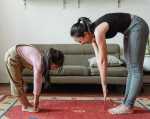Author Interviews, Blood Pressure - Hypertension, Exercise - Fitness, Heart Disease, JAMA / 05.08.2021
Exercise Training Can Provide Meaningful Blood Pressure Improvement
MedicalResearch.com Interview with:
Fernando Ribeiro PhD
School of Health Sciences
Institute of Biomedicine - iBiMED
University of Aveiro
Aveiro, Portugal
MedicalResearch.com: What is the background for this study? What are the main findings?
Response: Resistant hypertension is a puzzling problem without a clear solution. The available treatment options to lower blood pressure, namely medication and renal denervation, have had limited success, making nonpharmacological strategies good candidates to optimize the treatment of this condition.
Exercise training is consistently recommended as adjuvant therapy for patients with hypertension, yet, it is with a great delay that the efficacy of exercise training is being tested in patients with resistant hypertension.
Having that in mind, the EnRicH trial was designed to address whether the benefits of an exercise intervention with proven results in hypertensive individuals are extended to patients with resistant hypertension, a clinical population with low responsiveness to drug therapy. Exercise training was safe and associated with a significant and clinically relevant reduction in 24-hour, daytime ambulatory, and office blood pressure compared with control (usual care).
(more…)







 The first step that you should take to finding inner peace is to practice yoga and meditation regularly. Yoga and meditation can give you the chance to slow down and reflect, as well as to clear your mind of the worries and negative thoughts that are concerning you. Not only this, but deep breathing is also an important aspect of both yoga and meditation as this can help you to ground yourself and to reconnect with the world around you.
The first step that you should take to finding inner peace is to practice yoga and meditation regularly. Yoga and meditation can give you the chance to slow down and reflect, as well as to clear your mind of the worries and negative thoughts that are concerning you. Not only this, but deep breathing is also an important aspect of both yoga and meditation as this can help you to ground yourself and to reconnect with the world around you.

















 Dr Paul Gentil
Faculty of Physical Education and Dance
Federal University of Goias
Goiania, Brazil
MedicalResearch.com: What is the background for this study? What are the main findings?
Response: Although being overweight and/or obese are associated with numerous health risks, the prevalence of both are continuing to increase worldwide. The treatment would include anything that results in an increase in energy expenditure (exercise) or a decrease in energy intake (diet). However, our metabolism seems to adapt to variations in physical activity to maintain total energy expenditure. Although lower-than-expected weight loss is often attributed to incomplete adherence to prescribed interventions, there are other factors that might influence the results, such as, metabolic downregulation.
So, instead of making people spend more calories, maybe we have to think on how to promote metabolic changes in order to overcome these physiological adaptations above-mentioned. In this regard, high intensity training might be particularly interesting as a strategy to promote fat loss. Irrespective the amount of calories spent during training, higher intensity exercise seems to promote many physiological changes that might favor long-term weight loss. For example, previous studies have shown that interval training is able to promote upregulation of important enzymes associated with glycolysis and beta oxidation pathways, which occurs in a greater extent than with moderate intensity continuous exercise.
Our findings suggest that interval training might be an important tool to promote weigh loss. However, I t might be performed adequately and under direct supervision in order to get better results.
Dr Paul Gentil
Faculty of Physical Education and Dance
Federal University of Goias
Goiania, Brazil
MedicalResearch.com: What is the background for this study? What are the main findings?
Response: Although being overweight and/or obese are associated with numerous health risks, the prevalence of both are continuing to increase worldwide. The treatment would include anything that results in an increase in energy expenditure (exercise) or a decrease in energy intake (diet). However, our metabolism seems to adapt to variations in physical activity to maintain total energy expenditure. Although lower-than-expected weight loss is often attributed to incomplete adherence to prescribed interventions, there are other factors that might influence the results, such as, metabolic downregulation.
So, instead of making people spend more calories, maybe we have to think on how to promote metabolic changes in order to overcome these physiological adaptations above-mentioned. In this regard, high intensity training might be particularly interesting as a strategy to promote fat loss. Irrespective the amount of calories spent during training, higher intensity exercise seems to promote many physiological changes that might favor long-term weight loss. For example, previous studies have shown that interval training is able to promote upregulation of important enzymes associated with glycolysis and beta oxidation pathways, which occurs in a greater extent than with moderate intensity continuous exercise.
Our findings suggest that interval training might be an important tool to promote weigh loss. However, I t might be performed adequately and under direct supervision in order to get better results.





